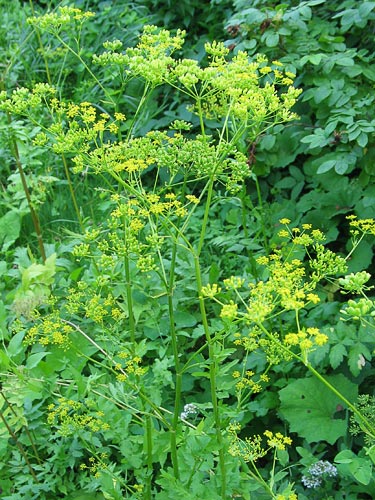Relatives
Pastinaca sylvestris Mill. - Wild parsnip.
Taxonomic position.
Family Apiaceae Lindl., Genus Pastinaca L.Synonyms.
P. sativa L. subsp. sylvestris (Mill.) Rouy & CamusMorphology and biology.
Biennial plant. Root is fusiform, woody. Stem is straight, 40-120 cm tall, sharp-ribbed, with short pubescence, branchy in the upper part. Leaves are simply pinnate, with short pubescence below and sometimes above, mostly along the veins. Petioles are 5-10 cm long, broadening into a sheath at the base. Leaf blade has an oblong contour and is 5-20 cm long. Folioles are ovate or oblong-ovate, short-pointed or obtuse, 2-5 cm long and 1-3 cm wide, full or superficially incised into 1-2 lobes, dentate along the edge. Terminal foliole is three-lobed. Umbels of inflorescences are solitary, set on the end of the stem and branches, 4-8 cm in diameter, with 8-15 (20) somewhat non-identical rays of peduncles, all of which may be fertile or without stamens at the end of the branches. Spathe and involucel are absent. Dentation of the calyx is imperceptible. Petals are yellow, rounded, about 1.5 mm in length and width, without a notch, with an obtuse, declinate tip. Fruit are yellowish brown, orbicular-elliptical, flatly compressed, 5-6 mm long and 4-5 mm wide; small channels are single in the sutures and paired at the commissure. Blossoms in June-July; bears fruit in July-August.Distribution.
Distributed worldwide in areas including southern Scandinavia, Central and Atlantic Europe, the Mediterranean Region and the Balkans. Naturalized in North and South America, Australia and New Zealand. In the former USSR, the species is distributed throughout the European region, Western Siberia, Eastern Siberia (along Yenisei), and the Caucasian region (Ante-Caucasus, Eastern and Western Transcaucasia, and Daghestan).Ecology.
Found on open slopes, in pastures, along roads, in crop lands, along field edges and in kitchen gardens.Utilization and economic value.
Close relative of sp. Pastinaca sativa L. (common parsnip); domesticated in early Middle Ages. Its fleshy root was an important part of the human diet in Europe before the introduction of the potato.Reference citations:
Bobrov E.G., Tsvelev N.N., eds. 1964. Flora of the USSR. Vol. 1-30. Moscow-Leningrad: Publishing House of the USSR Academy of Sciences. Index, p. 262. (In Russian)Cherepanov S.K. 1995. Plantae Vasculares Rossicae et Civitatum Collimitanearum (in limicis USSR olim). St. Petersburg: Mir I Semia. 990 pp. (In Russian)
Galushko A.I. 1980. Flora of Northern Caucasia. Vol. 2. Rostov: Publishing House of Rostov University, 272 pp. (In Russian)
Grossgheim A.A. 1967. Flora of Caucasia. Vol. 7. Leningrad: Nauka, 311 pp. (In Russian)
Malyshev L.I., Peshkova G.A., eds. 1979. Flora of Central Siberia. Vol. 2. Novosibirsk: Nauka, 690 pp.
Minjaev N.A. 1981. Manual of the higher plants of Northwestern part of the RSFSR (Leningrad, Pskov and Novgorod district). St. Petersburg: Publishing House of LGU, p. 271-272. (In Russian)
Peshkova G.A., ed. 1996. Flora of Siberia. Vol. 10. Novosibirsk: Nauka, 192 pp.
Shishkin B.K., ed. 1951. Flora of the USSR. Vol. 17. Moscow-Leningrad: Publishing House of the USSR Academy of Sciences, p. 216-217. (In Russian)
Tsvelev N.N. 2000. Manual of the vascular plants of Northwestern Russia (Leningrad, Pskov and Novgorod district). St. Petersburg: Publishing House of SPHFA, 515 pp. (In Russian)


